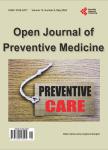Association between Weight Change during Treatment and Treatment Outcome in Patients with Smear Positive Pulmonary Tuberculosis
Association between Weight Change during Treatment and Treatment Outcome in Patients with Smear Positive Pulmonary Tuberculosis作者机构:School of Medicine Mashhad University of Medical Science Mashhad Iran
出 版 物:《Open Journal of Preventive Medicine》 (预防医学期刊(英文))
年 卷 期:2014年第4卷第6期
页 面:446-453页
学科分类:1002[医学-临床医学] 100214[医学-肿瘤学] 10[医学]
主 题:Pulmonary Tuberculosis Body Weight Change Treatment Outcome
摘 要:Tuberculosis (TB) is known as a disease of poverty and declared as a global public health emergency by World Health Organization (WHO). Pulmonary tuberculosis is the most common type of TB and is a wasting disease. It is expected that the patients who lost weight during the course of disease, will gain weight during successful treatment. So the aim of this study was to assess the body weight changes through the treatment and its possible association with treatment outcome in TB patients in Nishapur, an ancient city in Razavi Khorasan province in Iran. This is an observational analytical study. Patients were selected according to inclusion and exclusion criteria and available information. Treatment Protocol for all patients was Directly Observed Treatment, short Course Strategy (at least 6 months). All patients were weighed at the beginning of treatment, after two months and at the end of treatment. Outcome of treatment was classified into: cured, completed treatment, treatment failure and death. Then the impact of weight changes during treatment was compared in subgroups. From 874 patients, 819 patients (93.9%) were new cases, 48 (5.3%) relapse, 5 patients (0.6%) patients who did not complete their treatment and 2 (0.2%) had failed prior therapy. The most common symptoms in all patients were: cough, sputum, weight loss, fever, sweats, and hemoptysis. 8.1% of patients had radiologic signs and the most common signs were cavity (2.9%). The weight change during treatment was 2.91 ± 5.59 kg in cured group, 3.3 ± 3.29 kg in completed treatment group, 2.95 ± 5.59 kg in treatment failure group and 1.02 ± 3.27 in dead group respectively. These differences were statistically significant between the four groups (p 0.03). We can conclude that body weight change can be used as a predictor for the treatment outcome.



